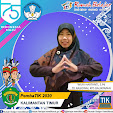Keyword: fitness circuit, PAUD
The appropriate learning activity for chidren is playing. Thus, a pre-school teacher should be able to develop a game that facilates all development of children or students. In Pembina Kindergarten Bumiaji Batu, the lack facility of learning instruments or media bringig on longer learning since the students have their turn in such a long time. This makes students, neither who already finish their task or still waiting for their turn tend to play for themselves. In addition, the learning activity especially motoric physical has not used an activity through a game.
This research aims to develop fitness circuit game on motoric physical learning for B group at Pembina Kindergarten Bumiaji Batu, an easy and joyful game for children to play. The research focus only to examine fitness circuit game on motoric physical learning especially for B group at Pembina Kindergarten Bumiaji Batu.
The writer uses development model with subjects of 40 students of B group at Pembina Kindergarten Bumiaji Batu. The phases are as follow: 1) requirement analysis, 2) create early product, 3) expert consideration, 4) first product revision, 5) small group test, 6) product revision, 7) field test, 8) final result.
Based on result of large group test (field test) it is recognized that 97.5% students stated that the can play the game easily and 92.5% said that they love to play it. The percentage classification is 80-100%, good to implemented. The positive value of the game are that: 1) the game can attract attention of the students, 2) learning being more cheerful, 3) it can train students to learn to be more concentrate and patient, 4) it can also train fitness of the children.
Based on the result, it is suggested that before applying the game, we need to give explanation of the game in the beginning to the students. Instruments used in the game should be adjusted with children condition. A further research may involves language development aspect or cognitive in the game.
Thursday, 28 October 2010
Artiani, Mei. 2010. Fitness Circuit Game Develpment on Motoric Physical Learning for B Group at Pembina Kindergarten Bumiaji Batu. Thesis, Elementary and Pre-school department, S1 Children Education for Early Ages (PAUD), Education Faculty, State University of Malang. Advisors: (I) Drs. Kentar Budhojo, M.Pd., (2) Drs. Heru Widijoto, M.S.
Hartanti, Wuri. 2010. Brain Gym Implementation to improve Children Early Writing Ability in A Group of State Kindergarten of Pembina Bumiaji. Thesis, Elementary and Pre-school Study Program, Education Faculty, State University of Malang. Advisors: (I) Dra. Wiwik Dwi Astuti, M.Pd., (II) Drs. Abdul Huda
Keyword: Brain Gym, Writing Ability, Kindergarten
Brain gym is a series of practices based on simple body gesture to facilitate learning activity and adaptation. Its easy gesture may assist to coordinate body and brain, thus if it is trained to children earlier may help them to learn faster. One of basic abilities can be improved with the brain gym is basic writing ability or skill of the children. After the implementation, it is hoped that the children of A group in State Kindergarten of Pembina Bumiaji acquire faster and better writing ability.
This research aims to (1) describe brain gym implementation in A group of State kindergarten of Pembina Bumiaji, and (2) to describe the implementation on children writing ability of the kindergarten.
The research uses Class Action Research (Penelitian Tindakan Kelas/PTK) held in two cycles. Every action includes planning, implementation, action, observation and reflection. Subjects of the research are students of A2 group of State Kindergarten of Pembina Bumiaji.
The result indicates that children average improvement of early writing ability in cycle I and II is increased. In cycle I, children writing skill shows average of 2.8 or70% of expected maximum score, their writing speed reach average improvement score 2.5 or 62.5% of expected maximum score, the accuracy of form/letter is 2.4 or 60% of expected maximum score, and the tidiness of writing is 2.3 or 57.5% of expected maximum score. In cycle II, children writing skill shows average improvement 3.5 or 87.5% of expected maximum score, their writing speed reach average improvement score 3.2 or 80% of expected maximum score, the accuracy of form/letter is 3.5 or 87.5% of expected maximum score, and the tidiness of writing is 3.3 or 82.5% of expected maximum score. And the whole average writing ability score is 3.4 or 85% of expected maximum score. It is known that from cycle I to cycle II gains 22.5% improvement.
Based on the result, it is concluded that the brain gym implementation is held by asking the children to play finger game, confronting right thumb with left little finger, right index finger with left ring finger, right middle finger with left middle finger, right ring finger with left index finger, and right little finger with left thumb, then rotating it over and over; arm activation by lifting their arms, then pushing them to the front, side and back; double doodle by making some squiggle with both hand at once, alphabet 8s by writing number 8 sleep.
By the implementation, it is recognized that students writing ability has increased. It can be observed from the result of cycle I and II. While in cycle I students writing ability is 62.5, in cycle II the number is up to 85%. Thus, the improvement is 22.5%.
From the result above, it is suggested that: (1) to improve students writing ability, the teachers can apply brain gym in learning activity of A group of State Kindergarten of Pembina Bumiaji; (2) this result can be used as policy reference by the head of the Kindergarten in overcoming poor early writing ability of the student; (3) this result also can be used as a reference for further research. Since its only covers only writing ability, speed, accuracy, and tidiness, future researcher may extent it to result of the children in form of letter, calligraphy, and others.
